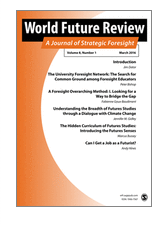Yes, but it ain’t easy!
It’s the number one question on the mind of prospective foresight students. Futurists are still struggling to find a foothold in the marketplace after 50+ years or existence. But let’s not waste another second complaining about it and focus on wha t we can do to improve the situation — first and foremost that includes continuing to do good work! My view is that alongside doing good work, we futurists ought to come together and provide just the bare minimum structure and direction to nudge the field from the fringe a bit toward the mainstream – note the word is “toward.” A balance between obscure and pop. So that new people interested in the field don’t have such a high bar to climb over. (I really do understand an opposing view that this “high bar” actually helps to make foresight “cool.” If you have the stuff to get over the bar, you have something on the ball. If the global need for foresight were not so pressing, I would be inclined to agree with this view. But it is. Really pressing. And we need as many trained professional futurists as we can get out there inspiring others.)
t we can do to improve the situation — first and foremost that includes continuing to do good work! My view is that alongside doing good work, we futurists ought to come together and provide just the bare minimum structure and direction to nudge the field from the fringe a bit toward the mainstream – note the word is “toward.” A balance between obscure and pop. So that new people interested in the field don’t have such a high bar to climb over. (I really do understand an opposing view that this “high bar” actually helps to make foresight “cool.” If you have the stuff to get over the bar, you have something on the ball. If the global need for foresight were not so pressing, I would be inclined to agree with this view. But it is. Really pressing. And we need as many trained professional futurists as we can get out there inspiring others.)
This nudging involves, I think, doing some work on getting our story straight and sharing it is a somewhat systematic fashion. Just that little bit, I believe, would go a long way toward making futurist a less difficult career choice.
The article suggests ways to improve the job prospects of futurists and, in turn, help build the field: (1) engage the jobs issue as a field, (2) build a profession, (3) develop a career ladder, (4) strengthen the academic base, and (5) promote the field. Preparing for our future is not a hobby, or a part-time job, but arguably the most important job that is drastically under-fulfilled. The time is ripe for thinking about our own future as a field to achieve our common purpose of spreading foresight
and doing our part to help make the world a better place.
Sage is making the articles in the March 2016 issue free for a limited time (a few more weeks) in the recently refreshed World Future Review – refreshed in the sense that Jim Dator and Aubrey Yee from the Hawaii “node” of foresight are now the editors. I am happy to have joined the Editorial Board as I see them taking the journal in a much-needed direction: “what will distinguish WFR from other futures journals is that (as a rule) it will not have articles about “the future” or “the futures of x”, but rather about futures studies as an academic and consulting discipline—the roots of futures studies, its present state, the preferred futures for futures studies itself.” That is great news in my book!!! Andy Hines
[…] frequently asked question I get as an educator is “can I get a job as a futurist? I tackled this important and relevant question previously. I’d like to suggest a different […]